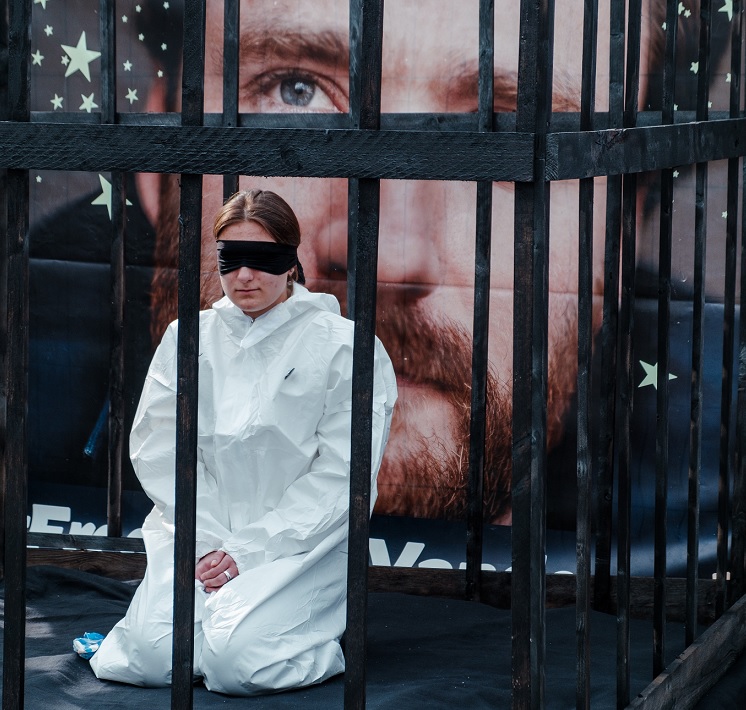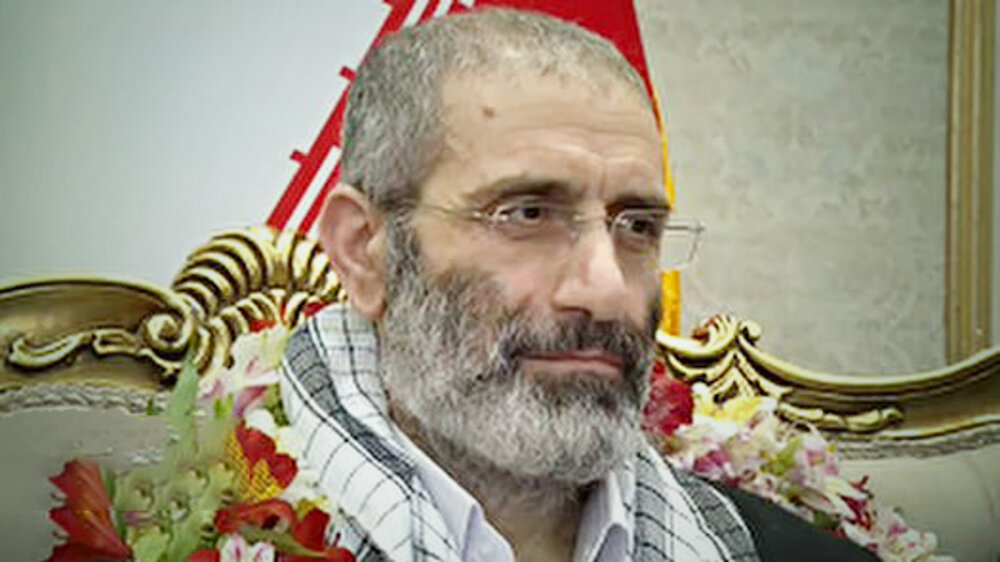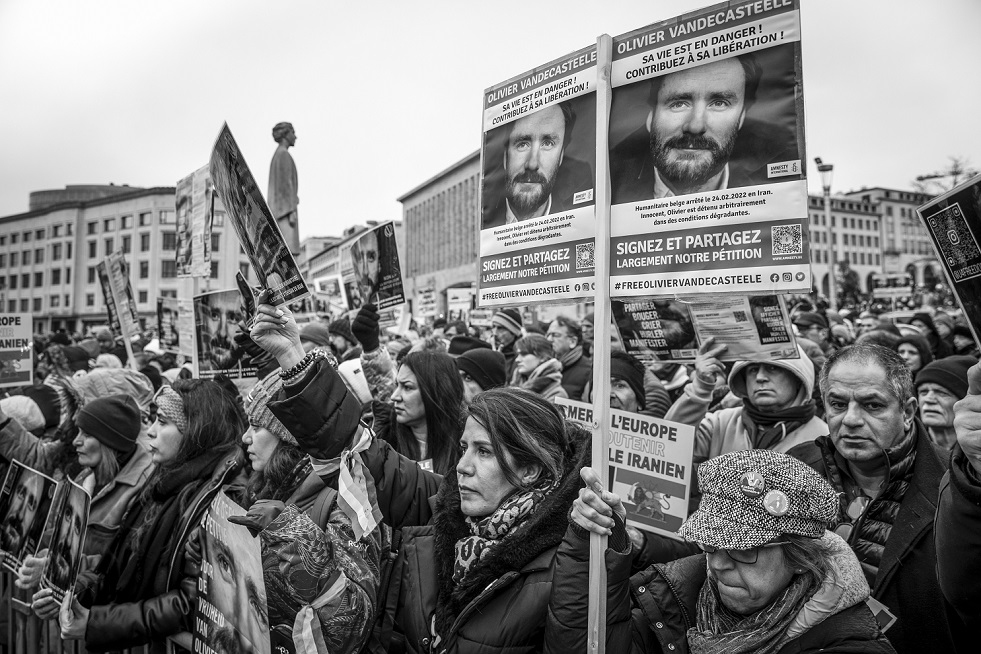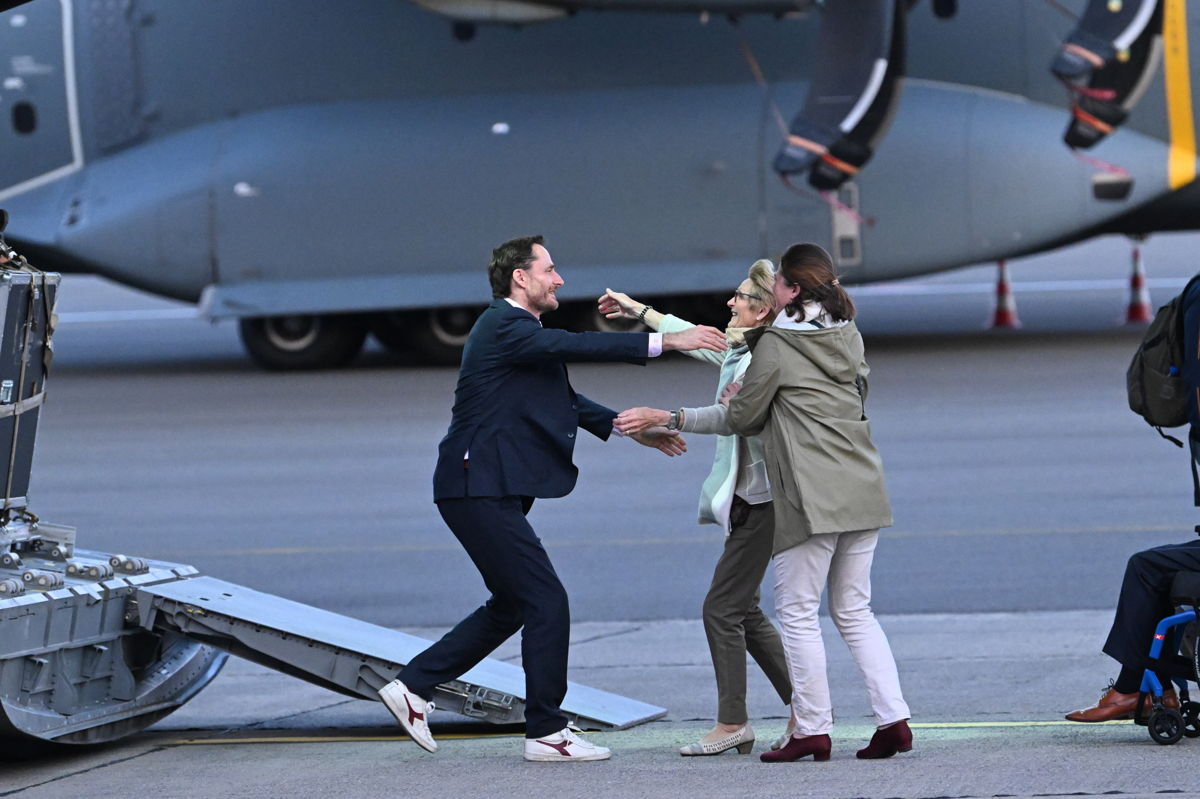On the last Friday of May, a military plane touched down outside Brussels and a man in a dark suit ran out, leaping into the arms of family members. The Belgian aid worker, Olivier Vandecasteele, was returning home after spending 15 months imprisoned in Iran.
If you live in Brussels, odds are you know what he looks like by now thanks to the ubiquitous posters adorning streetlamps, buildings and apartment windows all over the city. They feature a headshot — kind eyes looking upwards with the shimmer of hope taking centre stage — and a simple message: “Free Olivier Vandecasteele.”
Vandecasteele, from Tournai, was 41 when he was arrested in Tehran in February 2022. Before that, he worked in Iran from 2015 until 2021 with aid agencies Médecins du Monde, Norwegian Refugee Council (NRC) and Relief International, improving access to education, water and healthcare for Iran’s three million-strong Afghan community. In February 2022, he returned to the country on a tourist visa to pick up his belongings but found himself detained by Iranian authorities on charges of espionage.
The arrest shocked his family and friends, who knew him to be the opposite of a spy: he was seen as a genuinely decent man doing honourable work helping those in need. But these qualities meant little in Tehran, which saw him as a bargaining chip in a grand diplomatic game.
“Iran has a long-documented pattern of arbitrarily detaining dual and foreign nationals and using them as leverage,” says Nassim Papayianni, senior campaigner on Iran at Amnesty International. She says many nationals detained in Iran are hostages, whose release will only come after their home country offers concessions. “The crime of hostage-taking is a crime under international law,” she says.
Vandecasteele’s story became a cause célèbre. After his detainment was made public, his family and friends began mobilising the public to speak out and ask for his return. Amnesty International helped to spread awareness of their cause. “It’s one of the most successful such campaigns we’ve ever had,” says Philippe Hensmans, director of Amnesty’s Belgian section. “The most impressive part is all the initiatives that are taken locally in many, many cities in Belgium. People putting posters up in their windows, for example. It’s really remarkable.”
While imprisoned, Vandecasteele only spoke to his family over the phone occasionally. Olivier Van Steirtegem, Vandecasteele’s best friend and organiser of the campaign to bring him home, spoke to him a few weeks before his release. “It was extremely, desperately concerning. It was the first time in 18 days he had spoken to anyone,” he says.

Niece, Manon Vandecasteele, sits blindfolded in a cell on the Tournai Grand-Place.
He was tortured, kept in solitary confinement and refused access to proper healthcare (he would later say he lost 30kg in prison). Among those campaigning for his release was his niece, Manon Vandecasteele, who raised awareness by sitting blindfolded in a cell in Tournai’s Grand Place. The United Nations called his detainment and subsequent mistreatment “a flagrant violation of international law.”
The price for his release
Vandecasteele’s return to Belgium was a massive relief for his friends and families. However, his release came through a controversial, prisoner swap deal that could end up costing Belgium and the West dearly.
In exchange for setting Vandecasteele free, the Belgian government also released an Iranian diplomat considered one of the world’s most dangerous terrorists: Assadollah Assadi.
Assadi had been serving out a 20-year sentence in Belgium after being convicted of terrorism for attempting to bomb a rally of Iranian dissidents outside of Paris in 2018.
“It’s well known that the risk of Belgian citizens travelling to Iran dramatically increased from the moment Assadi was sentenced,” says Van Steirtegem, his best friend. “Olivier has been presented sometimes as careless or taking a big risk by travelling to Iran — which is not the case,” Van Steirtegem said. “He’s a humanitarian and it is as a humanitarian that he was arrested.”
So, who was Assadi? Officially, he was a diplomat working at the Iranian embassy in Vienna. In reality, he was an Iranian spy who was planning what would’ve been the bloodiest terror attack Europe has seen in recent history. Had it been successful, it could have killed more people than the Paris attacks in 2015 or the Madrid bombings of 2004.
In June 2018, the main association of Iranian dissidents in exile, the National Council of Resistance of Iran (NCRI), was to hold its annual rally — with tens of thousands of attendees coming in from across Europe and beyond. Foreign guests at the rally included former New York mayor Rudy Giuliani and former US Ambassador to the UN Bill Richardson.
After receiving a tip about a planned attack, Belgian, German and French authorities worked together to prevent it from happening by intercepting those behind the scheme.

Iranian diplomat Assadollah Assadi upon his release. He was convicted in a Belgian court for terrorism
Assadi brought the bomb from Iran in a diplomatic pouch on an Airbus flight. He had been followed by intelligence services when he travelled to Luxembourg to hand it to Amir Saadouni and his wife, Nasimeh Naami, who were set to carry out the Paris job. He was then arrested in Bavaria, as he was driving back to Vienna, his diplomatic immunity no longer protecting him, as he had left Austria. His trial for attempted terrorism took place in Antwerp, as that is where Saadouni and Naami lived.
Throughout the monthslong investigation, Assadi refused to cooperate. He only spoke up once, to make an ominous warning about how armed groups throughout the Middle East would be watching the trial carefully. “Belgium doesn’t realize what could happen in the event of an unfavourable verdict,” he is quoted as saying.
Assadi, Saadouni, Naami and a fourth accomplice would all be found guilty in 2021. He was sentenced to 20 years in prison, the first time an Iranian official was put on trial in the European Union for suspected terrorism since the Iran revolution of 1979. The Iranian government called the trial “illegal,” claiming Assadi should’ve benefitted from diplomatic immunity.
However, the Belgian government may have recognised Assadi’s warnings. Last month, a cyber-attack by Iranian dissidents on the foreign ministry resulted in a leak of classified documents that showed the government had already been discussing a potential exchange agreement between Belgian and Iranian nationals months before Vandecasteele’s arrest, suggesting that they might have already anticipated this outcome.
So it proved. Vandecasteele was arrested a year after Assadi was sentenced. This January, Iran charged him with espionage and sentenced him to 40 years in prison and 74 lashes.
Swap or blackmail?
The prisoner swap deal implies both men would carry out the remainder of their sentences in their native countries. After being approved by the government, it was frozen by Belgium’s constitutional court and only months later upheld again, fully coming into effect this March. While some opposition politicians have criticised the move, saying it could put other European citizens travelling to Iran in danger, Prime Minister Alexander De Croo backed it, saying he would do whatever it takes to bring Vandecasteele home.

Protest for Olivier Vandecasteele in Brussels in January
The NCRI, for its part, condemned the exchange as “a shameful dirty deal,” adding that, “the release of a terrorist diplomat 15 years before the end of his sentence encourages terrorism and betrays human rights.”
Colombian politician Ingrid Betancourt, who was held hostage for six years by a guerrilla group, said the prison swap would reward “the blackmail policy” of the Iranian regime. “As much as I am overjoyed and relieved with the release of a Belgian hostage abducted by the Iranian dictatorship, I am shocked and deeply appalled to see such a clear violation of the rule of law,” she said. “Releasing a dangerous terrorist such as Assadi will encourage the Iranian regime to more terrorism in Europe and more hostage-taking in the future.”
“The current regime has two pillars: repression at home and terror abroad,” says Shahin Gobadi, spokesperson for the National Council of Resistance of Iran (NCRI), whose rally Assadi attempted to bomb. “It has a defined policy of state terrorism in place. But when a bomb goes off, it does not distinguish between Europeans and Iranians.”
The NCRI was founded in Tehran in 1981 and positioned itself as the “viable democratic alternative” to the current theocratic republic ruled by a supreme leader appointed for life. NCRI leader Maryam Rajavi has spoken of her vision for Iran as a non-nuclear, secular democracy, with free elections and gender equality, the death penalty abolished, and foreign policy based on “peaceful coexistence.”
Just two days before Vandecasteele’s release, Rajavi attended a conference at the European Parliament on the demonstrations, as well as the executions the Iranian government has responded with. “The regime uses executions to prevent an uprising,” she said in her address before lawmakers. “Unfortunately, we are witnessing a lack of action from the European Union and its member states. Isn’t opposing the death penalty one of the well-known principles of the European Union?”
Iran has seen widespread unrest since the death in custody last September of Mahsa Amini, a 22-year-old woman protesting against the country’s so-called morality police for allegedly not respecting its strict hijab rules. Thousands of protesters have been killed since. But the protests have done little to stem the repression, or the hostage diplomacy. “For every prisoner Iran releases, it takes two more,” Gobadi says. “There’s never a shortage of inventory.”

